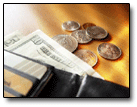 We all have our little fears. One of mine, oddly enough, has to do with reaching the end of a discount superstore checkout line:
We all have our little fears. One of mine, oddly enough, has to do with reaching the end of a discount superstore checkout line:
I have a cart-full of stuff. I put my stuff on the conveyor belt, and the cashier rings it up. I reach back for my wallet …
… and find nothing but an empty pocket.
Ack.
And right there is where my heart cliff-dives into my stomach.
Now, to be fair, my inner “fear” of this probably has more to do with me being placed in an awkward situation (needing to pay for stuff at checkout, but having no money to do it with) than it does with the actual loss of my personal filing cabinet (i.e., my wallet).
But in reality, it’s that second condition that would cause the larger turmoil. And dramatically so.
To date, I have never lost my wallet. But it occurs to me now that doing so would precipitate a huge mess in my life. I mean, I’ve never gone through any other guy’s wallets, but I suspect that I keep a lot of stuff in mine, relatively speaking.
Careful consideration suggests that having all that “stuff” fall into the wrong hands could prove to be really, really nasty. And taking a few actions now, plus having some sort of contingency plan in place should my fears be realized, is probably a really good idea.
Perhaps both of us, Dear Reader, should practice some wallet “preventative maintenance.”
Know “What’s In Your Wallet”
I will be deadly honest here: I have not inventoried my wallet in years.
If that thing disappeared tomorrow, would I know everything that it held?
Would I know what accounts were compromised?
Would I know what banks and institutions to call to notify and/or close those accounts?
Embarassing as it is to say, I certainly wouldn’t have those answers immediately. Sure, I could garner a lot of the required info from my Quicken 2010 Deluxe file, but that would take time. And it wouldn’t be exhaustive. For stuff like insurance cards, I’d need to dig through our filing cabinets as well. Which means more time. And more opportunity for bad stuff to happen with my information.
So obviously, knowing what’s in your wallet is key. With that in mind, it’s time to see what I can do to, uh, mitigate the potential damage.
Minimize Wallet Contents
The way I figure, the best way to keep your wallet from becoming some identity thief’s Jackpot of the Month is to make sure that said wallet is (1) as empty as possible, or (2) as full of useless crap as possible.
(When Mr. Thief scours all the hidden folds of your wallet, hoping to score a Benjamin or two, and finds only a couple of Arby’s receipts from 1997 … well, it’s fun to imagine the look on his face.)
In this vein, I’ve read that some guys don’t even carry their driver’s licenses in their wallets. Instead, they elect to keep it in their vehicle … say, in a glove-box wallet, or in a console compartment. While I understand the goal — don’t let the thief get your address, etc. — the side-effects seem way inconvenient to me. And what if your car gets stolen? According to at least one source (though a flimsy one), that’s way more likely to happen than having your wallet pilfered.
Anyway, considering your wallet’s contents, odds are that your name will be in there on SOMETHING. But if you’re good with keeping your driver license elsewhere, you might as well yank out anything else that could tip off a thief to your address, birthdate, workplace (think business cards), and other vitals. Why make identity theft any easier than it already is?
Don’t Be An Idiot
Yes, these should go without saying. But a little reinforcement can’t hurt.
Don’t carry your Social Security card in your wallet.
Don’t keep your Social Security number anywhere in your wallet.
Don’t keep ATM pin numbers in your wallet.
Do Consider Human Nature
If you think human nature matters, regardless of situation, then you might want to keep baby pics in your wallet, though. If you do, display them prominently. There’s no charge for playing to someone’s sympathies!
Think It Over: Debit vs. Credit
Remember: In the event of a wallet or purse mishap, debit cards will give Mr. Thief direct access to your bank account. Credit cards will not.
“Reward checking” programs that require some minimum number of debit-card purchases each month can bring pretty fat interest rates to your account. But there is a cost here that many people don’t consider: You’re making your debit-card info that much more available to folks who would like to do bad things with it.
(Lisa and I have had our credit-card accounts compromised at least once, and it was practically a non-event. We’ve never had our debit-card numbers fall into the wrong hands, thankfully, but we’ve heard from folks who have. And it wasn’t pretty.)
Inventory Those Wallet Contents
Now that we’ve cleaned out (hopefully) a bunch of peripheral stuff from our wallets, it’s time to do a bit of Contingency Plan record-keeping.
- Scan, photograph, or photocopy fronts/backs of cards.
- Keep a list of website URLs / contact phone numbers somewhere. (My personal choice is a filing cabinet, using a folder labeled WALLET INFO and the current date.)
- Keep photographs/scans/copies in safe place. (The above-mentioned filing cabinet seems good enough to me.)
After all this, we’ve hopefully done enough thinking ahead to mitigate some of the hassle associated with a lost wallet … should it ever occur!



 We all have our little fears. One of mine, oddly enough, has to do with reaching the end of a discount superstore checkout line:
We all have our little fears. One of mine, oddly enough, has to do with reaching the end of a discount superstore checkout line: